LAO Contact
March 30, 2022
The 2022‑23 Budget
Middle Class Scholarship Program
Summary. The 2021‑22 budget agreement included plans to revamp the Middle Class Scholarship (MCS) program beginning in 2022‑23. The Governor’s budget includes a $515 million ongoing augmentation to begin implementing the revamped program. Under the new program rules, University of California (UC) and California State University (CSU) students will receive MCS award amounts linked to their total cost of attendance, rather than tuition costs only. The new MCS rules also will add many more recipients, including low‑income students receiving Cal Grants. With these significant changes come new issues for the Legislature to consider. Given the complexity of the revamped program, one implementation issue to consider involves the state’s ability to continue providing timely notification of awards to students. Another issue to consider is that the revamped program could contribute to shifts in enrollment demand from the community colleges (where students are ineligible for MCS awards) to the universities. The revamped program also could reduce some incentives for students to contain their living costs as well as for campuses to contain their student housing charges. The last issue we discuss revolves around the options the Legislature has for phasing in financial aid expansions—including the option to expand living cost coverage through the Cal Grant program, potentially offsetting MCS costs.
Introduction
As part of the 2021‑22 budget agreement, the state revamped the MCS program, with the new program rules scheduled to go into effect in 2022‑23. The Governor’s 2022‑23 budget includes the agreed‑upon General Fund augmentation ($515 million) to implement the first year of the revamped program. We describe the revamped program and proposed augmentation in The 2022‑23 Budget: Student Financial Aid. In this follow‑up post, we explore the MCS program changes in greater detail. We first provide background on state financial aid programs, with a focus on the Cal Grant program as well as the original and revamped MCS program. We then examine the estimated impacts of the revamped MCS program. We conclude the post by raising some issues for legislative consideration as it implements the revamped program.
Background
Cal Grant Program Is State’s Longstanding Student Financial Aid Program. In the late 1970s, the state consolidated its financial aid programs into the Cal Grant program. The California Student Aid Commission (CSAC) administers this program. The state has multiple types of Cal Grant awards, with award amounts varying by type and segment. At UC and CSU, Cal Grants typically cover full systemwide tuition and fees (currently $12,570 at UC and $5,742 at CSU). In addition, low‑income students may receive an “access award” (currently $1,648) for living costs such as food and housing. Cal Grants have various eligibility requirements, including income and asset ceilings that vary by family size. In 2022‑23, a dependent student from a family of four must have an annual household income no greater than $116,800 to qualify for any Cal Grant award, and no greater than $61,400 to qualify for an access award. As Figure 1 shows, the Governor’s budget provides $2.8 billion for the Cal Grant program in 2022‑23, with $2.1 billion of this amount going to UC and CSU students.
Figure 1
Governor’s Budget Provides
$2.8 Billion for Cal Grants
2022‑23 (Dollars in Millions)
|
Segment |
Recipients |
Spending |
|
UC |
92,681 |
$1,164 |
|
CSU |
160,021 |
932 |
|
CCC |
215,153 |
413 |
|
Private nonprofit institutions |
28,861 |
251 |
|
Private for‑profit institutions |
5,684 |
30 |
|
Other public institutions |
32 |
—a |
|
Totals |
502,433 |
$2,792 |
|
aLess than $500,000. |
||
Original MCS Program Was Enacted in Response to Steep Tuition Increases. UC and CSU increased tuition during the Great Recession in response to state funding reductions. Between 2007‑08 and 2011‑12, systemwide charges for undergraduate resident students increased from $6,636 to $12,192 (84 percent) at UC and from $2,772 to $5,472 (97 percent) at CSU. The original MCS program (administered by CSAC) was enacted to help middle‑income UC and CSU students not receiving tuition coverage through the Cal Grant program receive partial tuition coverage. Awards cover between 10 percent and 40 percent of systemwide tuition and fees, with the percentage graduated downward as household income increases. State law caps spending on the original MCS program at $117 million annually and directs CSAC to prorate award amounts to remain under the cap, if needed. CSAC is prorating award amounts for the first time in 2021‑22. (As discussed in the nearby box, tuition charges at UC and CSU have been held about flat since 2011‑12.)
Recent Tuition Trends
Holding Tuition Charges Flat Since Great Recession Has Benefited Middle‑Income Students. Though tuition charges at the University of California (UC) and California State University (CSU) increased very quickly during the Great Recession, tuition charges subsequently have remained about flat. Between 2011‑12 and 2021‑22, UC and CSU raised tuition charges only once. In 2017‑18, UC and CSU increased undergraduate tuition charges by 3 percent and 5 percent, respectively. (UC also increased its systemwide Student Services Fee by 5 percent annually from 2015‑16 through 2017‑18.) As tuition charges have been held flat in most years, UC’s and CSU’s rising operating costs over the past decade have been covered primarily through higher state General Fund support. This budget approach particularly has benefitted middle‑ and high‑income tuition‑paying students. (Low‑income students generally have their tuition covered through state and institutional financial aid programs.) Whereas tuition‑paying resident students at UC contributed 23 percent of ongoing core funding in 2011‑12, they are contributing 11 percent in 2021‑22. Similarly, at CSU, tuition‑paying resident students contributed 35 percent of ongoing core funding in 2011‑12, whereas they are contributing 21 percent in 2021‑22.
Revamped MCS Program Focuses on Total Cost of Attendance. The revamped MCS program (also administered by CSAC) is very different than the original program. Rather than focusing solely on tuition, the revamped program is based on a student’s full cost of attendance, including living costs. As Figure 2 illustrates, calculating a student’s award amount under the revamped program will involve several steps. First, CSAC will account for other available gift aid, a student contribution from part‑time work earnings, and a parent contribution for dependent students with a household income of over $100,000. (We refer to these three factors collectively as students’ “available resources.”) It then will deduct these amounts from a student’s total cost of attendance to determine whether the student has remaining costs. Finally, CSAC will determine what percentage of each student’s remaining costs to cover each year based on the annual state appropriation for the program. Under this formula, award amounts will vary widely among students, with each student’s award reflecting their costs and available resources.
Figure 2
New Middle Class Scholarship Formula
Takes Effect in 2022‑23
Illustrative CSU Dependent Students Living Off Campus
|
Household Income |
Example 1 |
Example 2 |
|
Cost of attendance |
$29,344 |
$29,344 |
|
Other federal, state, and institutional gift aida |
‑10,635 |
— |
|
Student contribution from work earnings |
‑7,898 |
‑7,898 |
|
33% of parent contribution from federal EFCb |
— |
‑8,528 |
|
Student’s Remaining Costs |
$10,811 |
$12,918 |
|
Percentage based on annual appropriationc |
24% |
24% |
|
Award Amounts |
$2,595 |
$3,100 |
|
aThe amount also includes any private scholarships in excess of the sum of the student contribution and parent contribution. b Only applies to dependent students with a household income of more than $100,000. cState law requires the California Student Aid Commission to determine what percentage of each student’s remaining costs to cover each year based on the annual appropriation for the program. The Governor’s budget provides $632 million for the program in 2022‑23, which is enough to cover an estimated 24 percent of each student’s remaining costs. |
||
|
EFC = expected family contribution. |
||
Revamped MCS Program Serves a Broader Range of Students. Another key difference from the original MCS program is that UC and CSU students receiving tuition coverage through Cal Grants or other financial aid programs (who typically are lower‑income students) will be newly eligible for MCS awards under the revamped program. Middle‑ and higher‑income UC and CSU students generally will remain eligible for MCS awards. The revamped program generally maintains the income and asset ceilings in the original program, adjusted for inflation. For 2022‑23, the maximum annual household income to qualify for an MCS award will be $201,000 for dependent students. (For context, about 90 percent of tax filers in California are beneath this cap.)
Revamped MCS Program Is Much Costlier Than Original Program. In fall 2021, CSAC prepared a cost estimate for the revamped MCS program using more detailed student‑level data than was available when the 2021‑22 budget was enacted. Based on CSAC’s estimate, it would cost $2.6 billion to cover 100 percent of each student’s remaining costs after accounting for the students’ available resources (other gift aid, a student work contribution, and any applicable parent contribution). This is about $300 million more than the initial cost estimate at the time of budget enactment. At full implementation, the MCS revamped program would cost about 20 times more than the original program and only slightly less than the Cal Grant program.
Governor’s Budget Funds an Estimated 24 Percent of Program Costs. In accordance with the 2021‑22 budget agreement, the Governor’s budget provides an augmentation of $515 million ongoing General Fund for the revamped MCS program. When combined with current funding for the original program, the augmentation brings total program funding to $632 million in 2022‑23. This is enough to cover an estimated 24 percent of total program costs. State law directs CSAC to prorate all awards equally, such that awards would cover 24 percent of each student’s remaining costs. Figure 3 compares projected recipients, spending, and award amounts under the revamped program in 2022‑23 to the original program in 2020‑21 and 2021‑22.
Figure 3
Governor’s Budget Funds Significant Expansion of
Middle Class Scholarship Program
Key Information by Segment
|
2020‑21 |
2021‑22 |
2022‑23 |
Change From 2021‑22 |
||
|
Amount |
Percent |
||||
|
Recipients |
|||||
|
CSU |
43,772 |
47,025 |
245,901 |
198,876 |
423% |
|
UC |
11,649 |
12,825 |
114,211 |
101,386 |
791 |
|
Totals |
55,421 |
59,850 |
360,112 |
300,262 |
502% |
|
Spending (In Millions) |
|||||
|
CSU |
$77 |
$79 |
$426 |
$347 |
439% |
|
UC |
37 |
38 |
206 |
168 |
442 |
|
Totals |
$114 |
$117 |
$632 |
$515 |
440% |
|
Average Award |
|||||
|
CSU |
$1,759 |
$1,678 |
$1,731 |
$53 |
3.1% |
|
UC |
3,192 |
2,968 |
1,806 |
‑1,162 |
‑39.1 |
Program Impacts
Many More Low‑Income Students Will Receive Awards Under Revamped Program... Once the new program rules take effect in 2022‑23, the number of MCS recipients is estimated to increase from about 60,000 to about 360,000. The increase is due to students receiving tuition coverage through Cal Grants or other financial aid programs now being eligible for living cost coverage through the MCS program. As Figure 4 shows, the majority of the additional MCS recipients will be in lower‑income ranges.
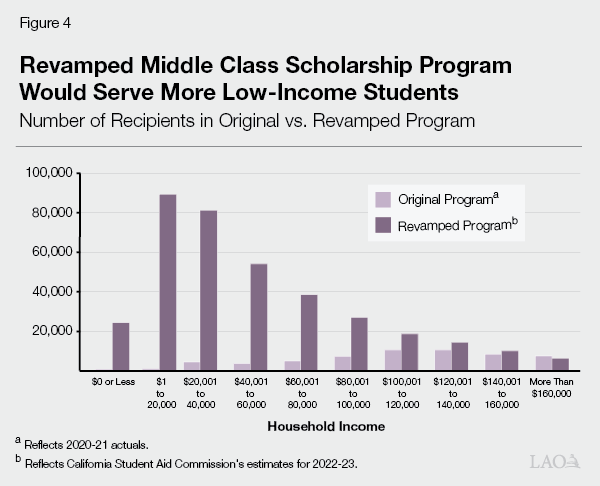
…But Low‑Income Students Will Receive Relatively Small Awards. Because the MCS program covers students’ remaining costs after accounting for existing aid (among other factors), MCS award amounts generally will be smaller for lower‑income students as they often also receive aid through Pell Grants, Cal Grants, and institutional aid. Figure 5 shows the estimated average award amount by income level at the Governor’s proposed funding level. Award amounts tend to increase with household income until the $100,000 threshold, when parent contributions begin. Even with parent contributions, the average award amount is higher for students with household income above the $100,000 threshold than below it.
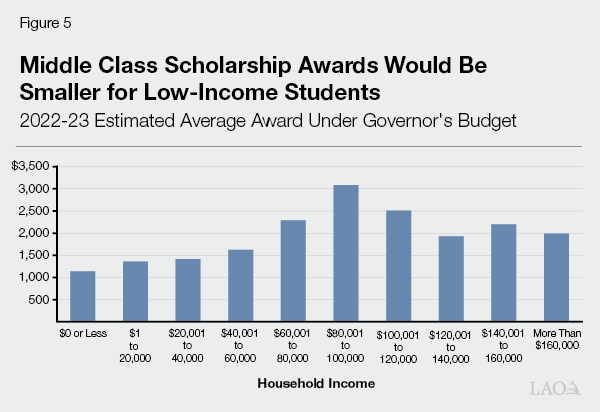
Net Price of Attendance Will Still Increase With Household Income. Although low‑income students generally will receive smaller MCS awards, their total financial aid package (including Pell Grants, Cal Grants, and institutional aid) generally will remain larger. This means the net price—the amount that students and their families pay after accounting for gift aid—still will tend to increase with household income. (This also generally occurs under the current financial aid structure.) Figure 6 shows the net price for an illustrative UC student living off campus at various income levels under two scenarios: (1) the Governor’s proposed funding level for the MCS program and (2) full implementation of the program. (The “full implementation” scenario assumes award amounts cover 100 percent of each student’s remaining costs after accounting for the student’s available resources.) At full implementation, the net price for all UC and CSU students with a household income of $100,000 or less would be approximately $8,000, which is the estimated amount a student could earn by working at minimum wage for 15 hours per week during the academic year.
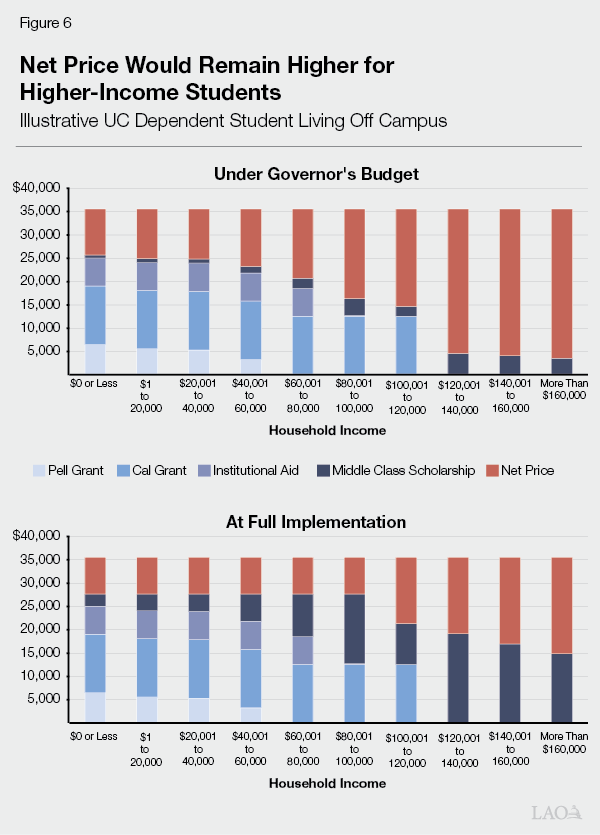
At Full Implementation, Net Price Would Be Highest at CCC for Many Students. Figure 7 shows the net price at full MCS implementation for an illustrative low‑income student living off campus. Although the MCS program would reduce the net price to about $8,000 if this student were to attend UC or CSU, their net price would remain higher (about $12,000) if they were to attend the California Community Colleges (CCC), where MCS awards are not available. This situation would apply to many CCC students across income levels, with the notable exception of students living at home with parents. Many CCC students who have the option of living at home could reduce their net price below that of UC and CSU students. This is because living at home results in a lower cost of attendance, yet in most cases, it does not affect financial aid award amounts at CCC. That is, CCC students typically receive the same amount of aid through Pell Grants, Cal Grants, and other financial aid programs regardless of their living arrangement.
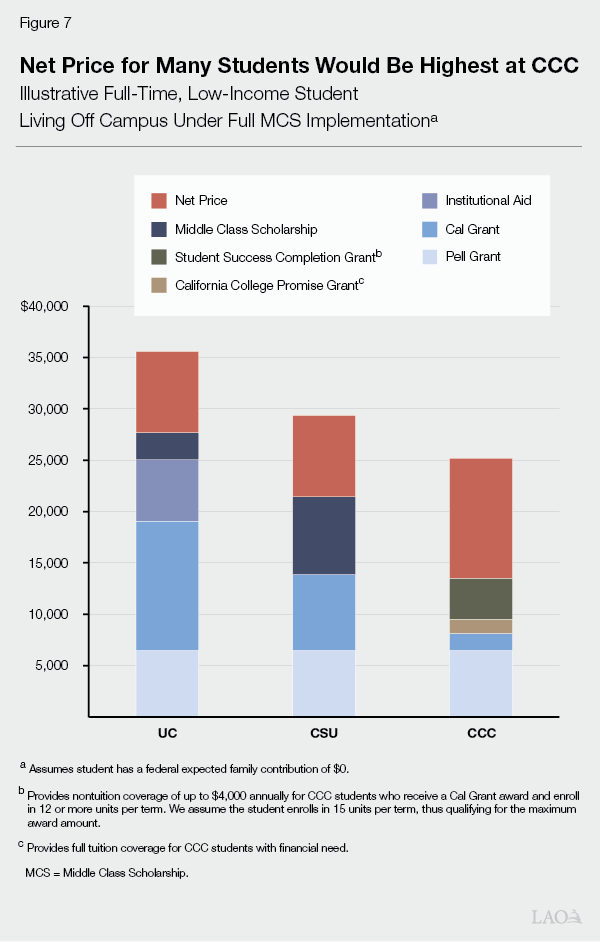
At Full Implementation, Net Price at UC and CSU Would Largely Be the Same Across Living Arrangements. Unlike CCC students, UC and CSU students under the revamped MCS program will see their financial aid packages change if their living arrangements change. This is because their MCS award amount will be linked to their cost of attendance. Figure 8 shows the net price at full implementation for an illustrative low‑income student. All else equal, students in more expensive living arrangements (on campus or off campus) will receive larger MCS awards than students living at home with parents. Once the MCS program is at full implementation, the illustrative low‑income student would have a net price of about $8,000 across living arrangements. (The amount would be slightly lower if that student is attending CSU and living at home with parents. Due to the student’s low cost of attendance and high amount of existing aid, the student would have a net price below $8,000 even without receiving any MCS award.)
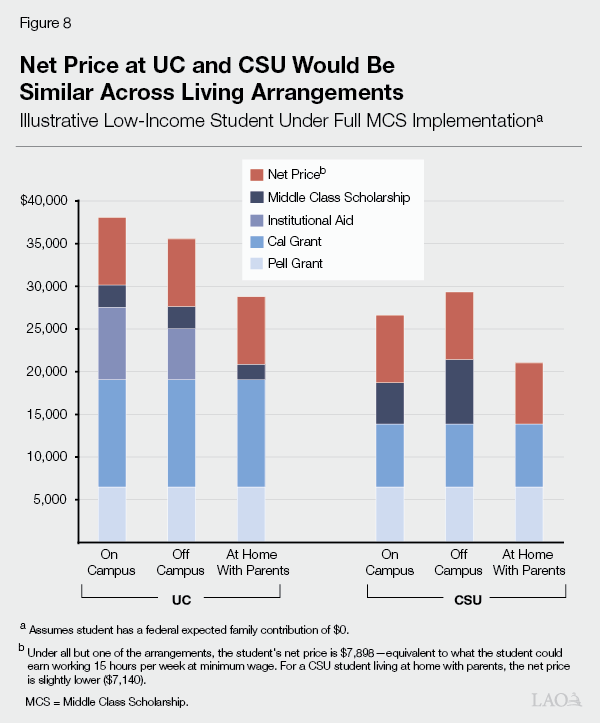
Issues to Consider
Revamped MCS Program Is First State Financial Aid Program Linked to Total Cost of Attendance. By linking award amounts to students’ total cost of attendance (including living costs), the revamped MCS program represents a significant departure from the state’s previous approach to financial aid at UC and CSU. The state’s longstanding Cal Grant program primarily provides tuition coverage, with an access award that covers only a small portion of living costs for the lowest‑income recipients. The Cal Grant access award has increased only slightly over the past two decades and has not kept pace with increases in students’ living costs, which roughly doubled over that period. (Whereas the access award covered roughly 15 percent of the living costs of a student living off campus in 2001‑02, it covers an estimated 7 percent today.) Under the revamped MCS program, the state will cover a larger share of students’ living costs. Moreover, once the program is fully implemented, award amounts would be adjusted annually to reflect changes in students’ cost of attendance. Award amounts would also vary widely among students based on their available resources. This new approach to state financial aid, especially when combined with the much higher income ceilings of the MCS program compared to the Cal Grant program, raises new issues for the Legislature to consider. We discuss these issues below.
Implementation Issues Could Impact Financial Aid Messaging to Students. The revamped MCS program requires CSAC to calculate individualized award amounts for an estimated 360,000 recipients. This will involve significant coordination with campus financial aid offices, particularly because CSAC will need data on the amount of other gift aid (including institutional aid) that each student is receiving. CSAC indicates the soonest it could calculate each student’s MCS award amount each year is in the summer, after campuses have completed their admissions cycle and initial financial aid offers have been made. This timing will mean students and families do not know how much MCS aid they will receive when making their enrollment decisions. The Legislature may wish to work with CSAC to explore options to simplify the process of determining MCS award amounts. Making the program easier to administer could allow for more timely notification to students, with greater potential to influence students’ college enrollment decisions.
Program Could Steer Students Away From Community Colleges. Once the MCS program is fully implemented, UC and CSU students would have their total cost of attendance covered, after accounting for their available resources. Many CCC students, however, would still have unaddressed costs. In particular, many students living off campus would have a higher net price if they were to attend CCC than if they were to attend UC or CSU. This gap could widen in future years, as MCS award amounts for UC and CSU students would be linked to students’ rising costs of attendance while state financial aid awards for CCC students historically have not been adjusted accordingly. To the extent students respond to the fiscal incentives created by the revamped MCS program, some enrollment demand likely would shift from CCC to universities. This redirection could exacerbate challenges with CCC enrollment, which was trending downward even before the pandemic and has declined more steeply during the pandemic. If the Legislature is concerned about these trends, it may wish to consider expanding financial aid programs that benefit CCC students, such as Cal Grants or Student Success Completion Grants (a program supported by Proposition 98 General Fund that helps cover living costs for CCC Cal Grant recipients enrolled full time).
Program Could Contribute to Increases in Cost of Attendance. Currently, students have an incentive to choose lower‑cost living arrangements, as this can reduce their need to borrow or work more hours. Campuses also have some incentive to keep their student housing charges relatively low to avoid deterring students from living on campus. Once the MCS program is fully implemented, both students and campuses will have fewer incentives to keep cost of attendance low. Students will have a similar net price across all living arrangements, meaning they would no longer have an incentive to contain their living costs. This could lead some students who have the option of living at home to instead choose to live independently off campus or on campus, with the state bearing the additional cost. Similarly, campuses could increase their housing charges, with the state bearing the additional cost on behalf of most students. Due to these concerns, the Legislature is requiring UC and CSU to begin reporting annually on the percent of students in each living arrangement and their associated cost of attendance. We encourage the Legislature to monitor this data closely. If the data show shifts to higher‑cost living arrangements or significant increases in on‑campus housing charges, the Legislature may wish to adjust the MCS formula. Adjusting the formula likely would involve changing how cost of attendance is determined for the purposes of calculating award amounts.
Legislature Has Multiple Options for Phasing in Financial Aid Expansions. Given the significant cost of covering students’ total cost of attendance (net of available resources), it might take several years or more to fully implement the MCS program. In the meantime, if additional ongoing funding is provided for financial aid, the Legislature has multiple options for prioritizing living cost coverage among students. One option is to continue providing augmentations for the MCS program, gradually increasing the percentage of each student’s remaining costs covered by the program (from 24 percent under the Governor’s budget to 100 percent at full implementation). This approach would spread the available funds to students across a very broad range of income levels. An alternate option is to prioritize expanding living cost coverage through the Cal Grant program. This would target the additional financial aid funding toward lower‑income students. Expanding Cal Grant access awards at UC and CSU would offset the cost of the MCS program at full implementation, as MCS awards are designed to cover remaining costs after accounting for other financial aid. We estimate that increasing the Cal Grant access award by $1,000 for eligible UC and CSU students would cost about $130 million annually, whereas increasing it for eligible Cal Grant recipients at all segments would cost about $300 million.
